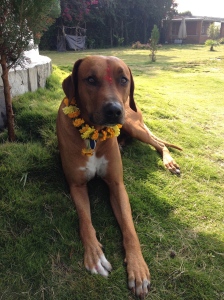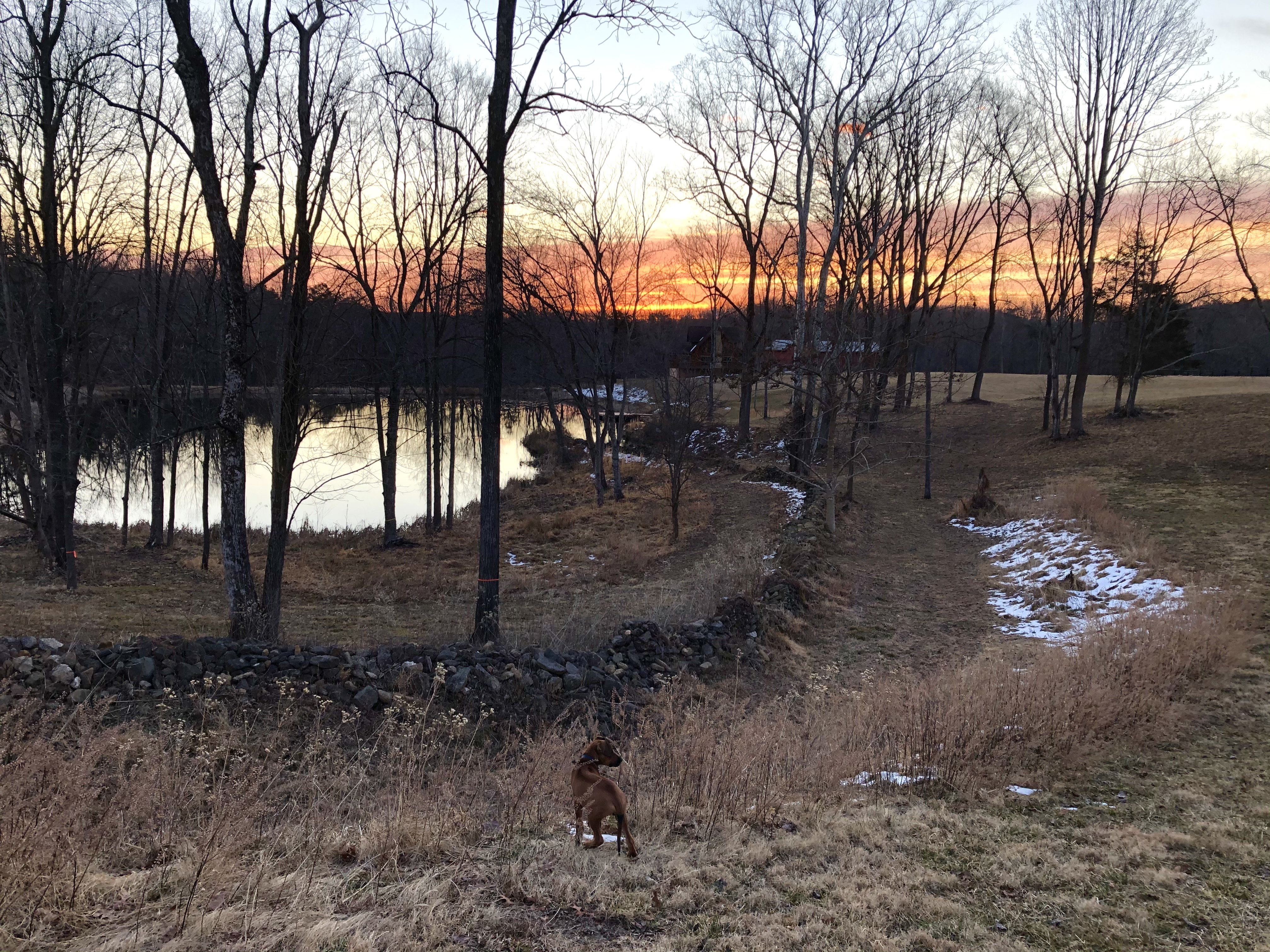
Boudhanath Stupa, a UNESCO World Heritage site is an island of calm in the chaos of Kathmandu. ©Donatella Lorch
It’s New Years this week in Nepal. Welcome to the year 2071. It has taken me almost a year to move the Gregorian calendar aside and understand strange names of months that now begin in what my previous life considered mid-month. Luckily my cell phone has helped me cope with the transition: ”Dear customer,” it told me on April 14th, “Applicable monthly charges will be deducted tomorrow on the 1st of Baisakh.”
I’ve had to do a lot of mental gearshifts. I used to think that having a New Year’s Eve celebration was normal but in Nepal there are seven New Years, each with their own celebration. Nepali culture is based on festivals: your god, my god, their god — any occasion is good.

During Laxmi Puja, a festival that celebrates Laxmi, the Goddess of Wealth, Nepalese light up the city with butter lamps and worship her in the temples. ©Donatella Lorch

My dog, Biko, gets worshipped on Kukur Puja, and receives a garland, a Tikka and sweet rice cakes. © Donatella Lorch
For a monotheist like myself who is only a church goer on three days a year (Christmas, Easter and a spare extra for good measure), who has also lived extensively in Islamic countries and who grew up in Manhattan where Jewish holidays were greeted by my father with a sigh of relief as alternate side of the street parking was suspended, I had never lived before with 330 million Hindu gods as well as Buddhist deities, demons and demonesses shared by both faiths. Early on, I started outlining in my diary Super God family trees as the top three male and female deities have multiple incarnations with their own offspring. There are official God festivals that can last more than a week. There are holy days for cows, dogs, crows and even airplanes.
Even if I wanted to, it is impossible to ignore these festivals and to continue life as it used to be in early 2013. Temples and Buddhist stupas are absolutely everywhere from sprawling ancient Hindu compounds to a stubby lingam that has split a paved road in two, a rock and a bell on the side of a road to the scores of huge ancient and holy pipal trees wrapped with string by worshippers. There are grass covered and white washed stupas dating back centuries whose gentle and humble elegance graces the chaotic polluted city of Kathmandu. Valley hillsides are dotted with gold painted rooftops that end in the airborne curling eves of Buddhist monasteries and nunneries.

The main prayer hall at Kopan Monastery, one of Nepal’s biggest Buddhist monasteries. © Donatella Lorch
There is an inclusiveness and a temperance to Nepal’s two main religions that is inspiring and beautiful. Tantric Buddhism is often the bridge between the two and whenever I visit a Hindu temple which often has a Buddhist stupa or icon on the premises, I always feel gratitude to have found a place where religions coexist.
Yet all these festivals, colorful, cacophonous, crowded, and often surreal from my western perspective, easily run week into week and can be a serious drag on economic growth in Nepal. There is no sense of urgency here but rather an overwhelming sense of fatalistic Karma. Whatever will be will be. National holiday or not, businesses and shops close without notice, people don’t show up for work, teachers as well as students can easily skip school. Government offices work on skeleton staffs and restaurants can close down for days on the big holidays of Dasain and Tihar. You don’t really notice this as a tourist (the tourism industry functions on a slightly more energized schedule) but living here sometimes becomes a frustrating effort at getting work done. It is also a sad statement about Nepal’s regional future. Labor productivity is a measure of economic growth and Nepal has one of the lowest labor productivity levels in the world. It has 22 percent unemployment. An inefficient, badly equipped education system means only 11 percent of students complete their secondary education creating a vast unskilled labor force where 25 percent of young Nepalese mostly men aged 20 to 39 have migrated to foreign countries as manual laborers. Government economic policies coupled with corruption hamper more than help the economy. The cost of doing business here is 23 percent more expensive than in China and 15 percent more than in India, its two huge and rather overbearing neighbors.

A solitary Shiva shrine sits amid wheat fields on the southern edge of the capital, Kathmandu. © Donatella Lorch
There is a phrase used often here, more of a philosophical statement about life in general that is accompanied by a resigned shoulder shrug. “Khe Garne?” loosely translates as “What can one do?” No answer is expected. I catch myself increasingly using that line. Have I surrendered? I wear a red string wrapped around my wrist blessed by a Buddhist monk. I’ll clank the bell at Shiva temples and when I run past mini Hindu shrines along village paths in Kathmandu’s outskirts, I think about how a touch of the forehead can express such powerful devotion.
I do believe that the Middle Way offers a beautiful path but I haven’t yet mastered mindfulness and compassion. And I have the greatest admiration for the owner of “The Secret Bakery”, one of Patan’s best bakeries. He is open through festivals, strikes and national holidays. Now that is a businessman with Chutzpah! Happy 2071.



Nepalis life seems to be very simple and. much more enjoyable
Love this one!
Happy to discover this blog. I will be returning to Patan myself in about a month, would be happy to meet you there and compare notes. I love your writing!